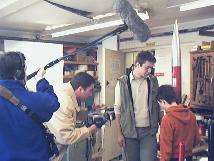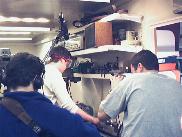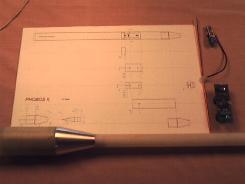BBC TV film Phobos II

Saturday the 26th of February and an early morning start saw MARS members bleary eyed as they awaited the BBC TV film crew to arrive at the Phobos II construction site in north west London. The rocket, which is the second in the HPR series of altitude attempt vehicles is being built for the Tomorrows World Live Lab programme, due to air on March the 22nd.

Ben Jarvis was interviewed regarding the current altitude record holder for a UK built rocket, held by Transient Glory which flew at Black Rock desert in August 1998. This rocket flew to an Altitude of 14,006' and the altitude has not been reached since. The upcoming television programme will see MARS attempting to keep the title of altitude record holder with the vehicle Phobos II.

The Phobos II high altitude rocket is a minimum diameter boosted dart, constructed from Aluminium, Steel and Fibreglass. These materials ensure that the vehicle is strong enough to survive the 30 plus G's it will experience at launch. The expected burn out velocity is over 1000mph, so the use of phenolic and other typical HPR rocket materials was not an option. A boosted dart works by having two stages a booster and an upper unpowered stage (the dart), the booster accelerates the whole stack hard at launch to high velocity. At motor burnout the booster which has a much higher drag than the thin arrow like upper stage is pulled away by the resistance of the air flowing over the rocket. The dart, which has a tail cone in addition to a nose cone is designed to have as low a coefficient of drag as possible in order to get the maximum altitude out of the energy imparted to it via the booster. The upper stage coasts on up to apogee, at which point the recovery system deploys and brings the whole upper stage back to earth.

In order for the booster to be recovered safely, electronics are employed to fire the ejection charge for its very own parachute, which slows the stage's decent to the ground. The electronics in the payload section of the dart, in addition to deploying the parachutes, determine the altitude reached, and allow the rocket to be found again using radio tracking equipment and audio beepers.
A complete article on the vehicle will be published on the web site after the programme airs, well we don't want to give everything away to the competition do we. :)










